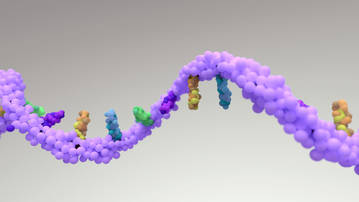The screening of microbial resistance genesis an important step in obtaining genes
with resistance functions from microorganisms for research and application purposes.
The following are several common methods for screening microbial resistance genes.
Natural selection method is the most fundamental screening approach, which involves selecting microorganisms with resistance based on their growth on culture media containing specific antimicrobial drugs for further genetic screening. The advantage of this method lies in its simplicity and feasibility, although it requires a longer period of cultivation and observation. Additionally, the types and quantity of resistant genes obtained through this method are limited.
Genomic library screening is a method that involves constructing microbial genomic libraries and using techniques such as real-time PCR to screen each clone in the library, identifying clones containing resistance genes and expressing them.
This technique involves the meticulous construction of comprehensive genomic libraries derived from diverse microbial strains, representing a broad spectrum of genetic information. The libraries serve as repositories of the entire genomic content of these microorganisms. Once identified, the selected clones harboring antimicrobial resistance genes are further characterized through gene expression analyses. These analyses involve the transcription and translation of the detected genes, providing insights into the functional attributes of the resistance determinants.
High-throughput sequencing methodologies have transformed the examination of antimicrobial resistance (AMR) by providing unparalleled insights into the genetic composition of microbial populations. These sophisticated sequencing technologies, encompassing metagenomics, facilitate swift and exhaustive analyses of microbial genomes. This capability enables the precise identification of resistance genes and the evaluation of their prevalence across diverse environments. Through the utilization of high-throughput sequencing, researchers can elucidate the intricate mechanisms that underlie antimicrobial resistance, discover novel resistance determinants, and track the dissemination dynamics of resistance genes. The integration of metagenomic and transcriptomic datasets further refines our comprehension of the molecular foundations of resistance, illuminating gene expression patterns and regulatory networks. This multidimensional approach not only expedites the identification of emerging resistance threats but also advances the formulation of targeted strategies for efficacious intervention and surveillance in the ongoing combat against antimicrobial resistance.
Random Transposon Mutagenesis Screening Method for Antimicrobial Resistance Gene Detection
The Random Transposon Mutagenesis Screening Method represents a sophisticated and widely employed technique in molecular biology for the identification and characterization of antimicrobial resistance genes within microbial genomes. This method leverages the strategic insertion of mutations into the microbial genome through the use of transposons, which are DNA elements capable of moving to different locations within the genome.
In the initial phase of this approach, a diverse population of microbial cells is subjected to random transposon mutagenesis, inducing the introduction of mutations across the genome. This generates a library of mutant strains, each carrying distinct alterations in their genetic makeup due to the insertion of transposons at random locations. The ensuing screening process involves exposing this diverse pool of mutants to antimicrobial agents, thereby selecting for strains that exhibit resistance to specific antibiotics or antimicrobial compounds.
Following the identification of these resistant mutants, the subsequent steps involve isolating, cloning, and expressing the resistance genes harbored by these strains. This process is meticulously carried out through molecular cloning techniques, which allow for the precise isolation and propagation of the genomic fragments encompassing the transposon-inserted resistance genes.
The isolated resistance genes are then expressed to elucidate their functional roles and mechanisms of action. This phase involves the transcription and translation of the identified genes, enabling researchers to gain insights into how these genetic determinants confer resistance to antimicrobial agents.
The Random Transposon Mutagenesis Screening Method provides a powerful and unbiased approach for exploring the vast landscape of antimicrobial resistance mechanisms encoded within microbial genomes. Unlike targeted methods, this technique allows for the discovery of novel resistance genes and pathways that may not be readily apparent through other screening strategies.
Yeast Two-Hybrid System Screening Method for Antimicrobial Resistance Gene Detection
The Yeast Two-Hybrid System Screening Method, a cornerstone in molecular biology, employs a protein interaction-centric approach to discern genes associated with antimicrobial resistance. Through the meticulous construction of yeast hybrid strains expressing diverse proteins, researchers systematically probe for interactions among these proteins. This discerning process enables the identification of genes conferring resistance to antimicrobial agents. By focusing on the intricate interplay between expressed proteins, this method offers a nuanced understanding of the molecular underpinnings of microbial resistance. The Yeast Two-Hybrid System's ability to unveil both known and novel resistance genes positions it as a powerful tool in deciphering the complex network of genetic determinants influencing antimicrobial resistance.
Phage Display System Screening Method for Antimicrobial Resistance Gene Detection
The Phage Display System, a pivotal tool in molecular biology, facilitates the presentation of peptides or proteins on bacteriophage surfaces, allowing for an in-depth exploration of antimicrobial resistance genes. Through the construction of a meticulously designed phage display library, researchers systematically screen for genes exhibiting specific functions related to antimicrobial resistance. This method encompasses the identification, subsequent expression, and detailed characterization of these genes. By harnessing the distinctive capacity of the phage display system to showcase a diverse array of molecular entities, this approach provides a comprehensive understanding of the genetic determinants associated with antimicrobial resistance. The systematic screening and expression procedures inherent in the Phage Display System contribute to a nuanced exploration of the molecular intricacies underlying microbial resistance mechanisms, establishing it as an invaluable tool in the intricate landscape of antimicrobial resistance gene detection.
Protein Chip Screening Method for Antimicrobial Resistance Gene Detection
The Protein Chip Screening Method, an advanced technology in molecular biology, involves immobilizing an extensive array of proteins on a chip surface. Merging microbial cell lysis with protein chips, this method enables the screening of resistance-related proteins, subsequently allowing for their expression and identification. This sophisticated approach expedites the detection of resistant genes, providing a rapid and effective means of unraveling the molecular determinants of antimicrobial resistance. However, the implementation of this method demands a high level of proficiency in molecular biology techniques. The integration of microbial cell lysis with protein chips enhances the efficiency of screening, making this method instrumental in advancing our understanding of antimicrobial resistance gene detection, albeit necessitating expertise in molecular biology for optimal utilization.
Affinity Chromatography Method for Antimicrobial Resistance Gene Detection
Affinity chromatography, a foundational technique in molecular biology, exploits the precise interactions between antibodies or ligands and target proteins for their separation and purification. This method involves the creation of affinity chromatography columns, each designed to express specific antibodies customized for the target proteins of interest. Through a meticulous screening process for protein binding to these antibodies, researchers can subsequently express and identify genes associated with antimicrobial resistance.
This strategy provides a swift and highly effective approach to screening for resistant genes, facilitating the exploration of molecular determinants that underlie antimicrobial resistance. However, the successful implementation of this method requires a profound mastery of molecular biology techniques to ensure the accurate construction of affinity chromatography columns and precise identification of the target proteins. The amalgamation of specificity and efficiency inherent in this approach positions it as a valuable tool for advancing our comprehension of antimicrobial resistance gene detection, underscoring the critical role of technical expertise in its execution.
Applications of Antimicrobial Resistance Gene Detection
Microbial resistance gene screening has a wide range of applications, and here are some key application areas.
Biopharmaceutical
Microbial resistance gene screening holds diverse applications, particularly in the biopharmaceutical sector, where its impact is profound. In the realm of biomedicine, the screening of microbial resistance genes assumes considerable significance. The widespread use of antibiotics has precipitated an escalating challenge of bacterial resistance, necessitating innovative approaches. Through meticulous screening, researchers can unveil novel resistance mechanisms, offering crucial insights for the development of advanced antibiotics. This method proves invaluable in addressing the pressing healthcare concerns posed by antibiotic-resistant bacteria.
Furthermore, microbial resistance gene screening extends its reach to cancer treatment within the biopharmaceutical sector. The identification of genes associated with anticancer medications through screening enhances the efficacy of drug therapy. By deciphering the genetic factors influencing drug response, scientists can optimize treatment strategies, paving the way for more effective and personalized cancer therapies. This dual application highlights the versatility and transformative potential of microbial resistance gene screening in advancing both antibiotic development and cancer treatment within the biopharmaceutical domain.
Agricultural
Antimicrobial resistance gene detection in agriculture holds multifaceted applications crucial for sustainable practices. By monitoring resistance gene prevalence, it enables targeted interventions in livestock health, crop protection, and food safety. This approach facilitates proactive measures to mitigate the spread of resistance, ensuring the well-being of agricultural ecosystems and enhancing the safety of food products. The identification of resistance genes in pathogens supports disease management without overreliance on antimicrobials, promoting environmentally conscious farming. Overall, the application of antimicrobial resistance gene detection contributes significantly to advancing resilient and responsible agricultural practices.
Food Safety
As the food industry undergoes continuous development, concerns related to food safety have garnered heightened attention. The systematic screening of microbial resistance genes serves as a crucial tool in this context, enabling the identification of potentially harmful microorganisms present in food, thereby enhancing its overall safety profile.
Moreover, delving into the intricate mechanisms of microbial resistance within the food safety domain offers a platform for the development of innovative solutions. By comprehensively studying these mechanisms, researchers can contribute to the creation of novel food preservatives. This not only addresses the imperative of extending the shelf life of food products but also aligns with the broader goal of enhancing food safety standards. The strategic exploration of microbial resistance genes in the context of food safety thus stands as a multidimensional approach, promoting both the identification of potential hazards and the development of preventive measures within the food industry.
Clinical Medicine
In the field of clinical medicine, the investigation of microbial resistance genes holds considerable significance and practical relevance. The widespread use of antibiotics has spurred the continuous development of bacterial resistance, posing significant challenges in clinical treatment. The systematic screening and comprehensive study of resistance genes become imperative in this context, offering a pathway to identify novel mechanisms and treatment strategies aimed at enhancing clinical efficacy.
Moreover, delving into microbial resistance mechanisms not only shapes treatment approaches but also contributes to the innovation of diagnostic tools and methods. The insights gleaned from such investigations serve as a foundation for developing novel diagnostic reagents, elevating the accuracy and efficiency of disease diagnosis. In essence, the strategic exploration of microbial resistance genes in clinical medicine not only addresses challenges posed by antibiotic resistance but also propels advancements in therapeutic strategies and diagnostic precision, significantly impacting the landscape of clinical practice.












